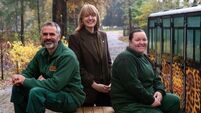Our ‘homicidal heron’ seems to have defended his lunch prize

I was sitting under a tree on a sweltering day in the Czech Republic when my mobile rang and Kevin Hanly, on the line from west Cork, told me that he and his wife Beth had found a dead heron in our driveway when they’d crossed the lane from their house to feed our domestic heron, as they always do during our absence.

Their heart-stopping conclusion was that the corpse was that of Ron, the heron that my wife and I had, seven years ago, taken in as a fledgling fallen from his natal tree and lost in the forest, and ‘reared’ to adulthood and independence, independence of which he did not avail preferring instead to spend much of his time in our garden, arriving mid-morning for a free breakfast of unfrozen sprats.
So named by my English daughter-in-law because it rhymed with ‘heron’, he was much beloved, especially of Beth, who insisted I did not cook him for Christmas.
The immediate reaction of the Hanlys was shock and dismay. Although he could be a bother during the breeding season, demanding food to regurgitate into the voracious beaks of his nestlings four or five times a day, his antics — preening, bathing in the garden pond, performing yoga contortions, posing for photos for all who set eyes on him— were much admired and he would be a great loss.
But there he lay, a lifeless bundle of grey and white feathers, dowdy in death on the gravel path. Herons are not normally garden birds, foraging in the flower beds and nesting in the shrubbery.
So the Hanlys, upon seeing the corpse assumed, as we would have ourselves, that a heron in the garden must be Ron. Then, however, Kevin walked into the back yard and to his surprise and relief, saw there, statuesque and elegant, Ron himself, preening at the pond and turning his head to acknowledge the arrival of breakfast.
His surrogate minders should, of course, have noticed that the dead heron did not carry a two centimeter spiral of green garden hose on one leg, as did Ron.
They assumed it was him. My wife and I would, I’m sure, have jumped to the same conclusion: it would be too far fetched to conclude that some out-of-town heron had happened to nose dive to Heron Valhalla in our front garden.
Also, the identifying marker was likely obscured by feathers and not to be seen.
So, as Kevin told me on the phone, they returned to the corpse to examine it. How could it have died? And why did it die where it did?
He and I puzzled over these questions via our mobiles. The dead bird had to be ascribed to Ron, we feared, Ron and territory.
Meet our Homicidal Heron, my wife murmured. The alliteration was excellent but, of course, it was a bird he’d bumped off, not a human. So, Ron the Fratricidal Heron?
Yes, but maybe it wasn’t a brother but one of his own offspring starting out in life, looking for territory. So, Ron the Filicidal or Ron the Sororicidal Heron? (I had to look that one up!)
My preference would be the offspring-seeking-territory conclusion. Ron has had more than one stand-off on the same piece of driveway, he and another heron shaping up, circling one another, feathers ruffled, uttering squawks.
On one occasion, a large, mature heron and a smaller, younger bird arrived and, together, tried to fly rings around our Ron, one landing in the back yard while the other distracted him in the front.
But he puffed out his chest, raised the black crest on his crown and frightened them off the premises, never to return.
What young heron wouldn’t compete for a bountiful lunch-counter, and what lunch- counter beneficiary wouldn’t defend such a prize? It might be a piece of shoreline yielding sand dabs, sand eels, and soft crabs; it might be a prime spot outside a fish-gutter’s workshop, or on a pier.
Herons are opportunistic, and if they have a fecund territory, they will defend it. So, Ron did the natural thing. But it is unusual for herons to fight to the death.
In the scientific literature I can, so far, find only one report of a heron killing another; cracking its skull in a territorial dispute (H Z Richner in British Birds 1985).
Kevin Hanly, an ex-“Huntin’, Shootin’ and Fishin’” man, had the nous to put the dead bird in the freezer awaiting a postmortem upon our return.
The postmortem isn’t yet done and I’ve run our of space in telling the back-story.
I will report further next week. Our Ron may be of interest to animal behaviourists and to science.













